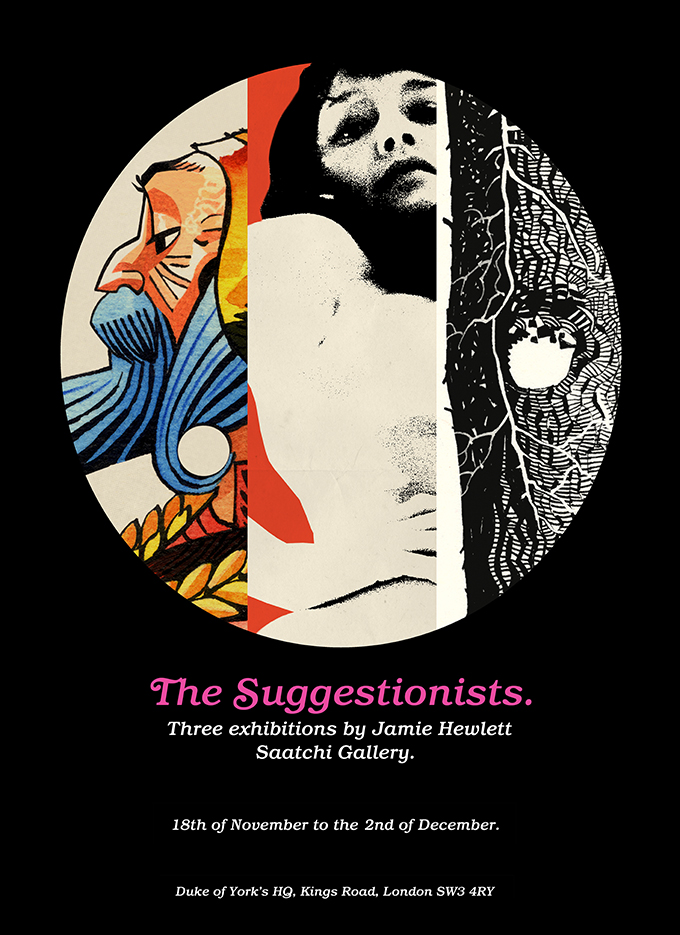JAMIE HEWLETT: THE SUGGESTIONISTS
‘The Suggestionists’, the first ever art exhibition from renowned artist and designer Jamie Hewlett, at the Saatchi Gallery. Presenting three brand new bodies of work, “The Suggestionists” reveals an entirely different side of Hewlett, albeit one that is still shot through with the same inimitable sense of wit and mischief with which he has made his name.
Following on from decades of gleeful graphic art rebellion, during which he cultivated a post punk phenomenon with the comic “Tank Girl” and founded Gorillaz, the world’s first virtual pop band with Blur’s Damon Albarn, “The Suggestionists” finds Hewlett turning his talents to fine art. Through a series of strikingly different galleries, Hewlett guides the viewer through a psychogeographic journey that is by turns hallucinatory and dreamlike, illicit and subversive, all linked through the tantalising power of suggestion.
In the first gallery is “Tarot”, Hewlett’s idiosyncratic, breathtaking interpretation of the world of tarotica. Extrapolating from magic realist Chilean art film auteur Alejandro Jodorowsky’s reconstruction of the original Tarot de Marseille – which he considers the one true Tarot – Hewlett has produced 22 larger than life Tarot cards, reconciling Jodorowsky’s uniquely psychoshamanic sensibilities with his own distinct stylistic signature. In Hewlett’s playful, beautifully rendered appropriation, familiar looking creatures clamber over “La Roue De Fortune”, the finely detailed expressions of the characters in “L’Amoureux” belie the romantic dilemma the young man faces, a trademark monkey even replaces the traditional dog in “Le Mat”; it’s a welcome intrusion of sly absurdity into the arcane and divine.
The viewer is then enveloped in thrilling darkness for “Honey”, the next segment of the exhibition, as Hewlett reveals his frisky homage to the exploitation movies of the 60s and 70s. With a series of giant lightboxes providing the only source of illumination, the space evokes the deliciously sleazy ambiance of an adult cinema lobby, with Hewlett completing the atmospheric hat trick by creating fake vintage movie posters which use gloriously trashy directors such as Russ Meyer and Terry Southern as an irreverent jumping off point before careering recklessly in his own direction. Revolving around the fictional character of “Honey”, Hewlett draws deeply from the lexicon of B-movie language to create posters which are bold, audacious, saucy and, at the same time, deeply authentic – right down to the affectionately rude credits.
From the nocturnal to diurnal then, as Hewlett brings the viewer blinking into the daylight with “Pines”, the final, most lyrical section. Featuring extraordinarily detailed illustrations of trees Hewlett observed while in the south of France, these large-scale drawings may look simple but are in actual fact astonishingly meticulous – almost photo realist – in execution and highly evocative, conjuring a heady, magical, bucolic landscape with all the wide-eyed innocence of a fairytale. It is a fitting finale to a show in which hetereogeneous images of the conscious and unconscious, everyday and fantastical, all occupy the same space, emphasising how strictures can be undermined or heightened simply by the power of suggestion.
Jamie Hewlett lives and works in Paris. He first rose to prominence with his comic “Tank Girl”, which gained a cult following and was made into a movie in 1995, with work for magazines, advertising and television following suit, not to mention Hewlett founding Gorillaz alongside Damon Albarn. 2007 saw the pair collaborating with Chen Shi-Zheng on the opera “Monkey: Journey to the West”, which premiered at the Manchester International Festival.







